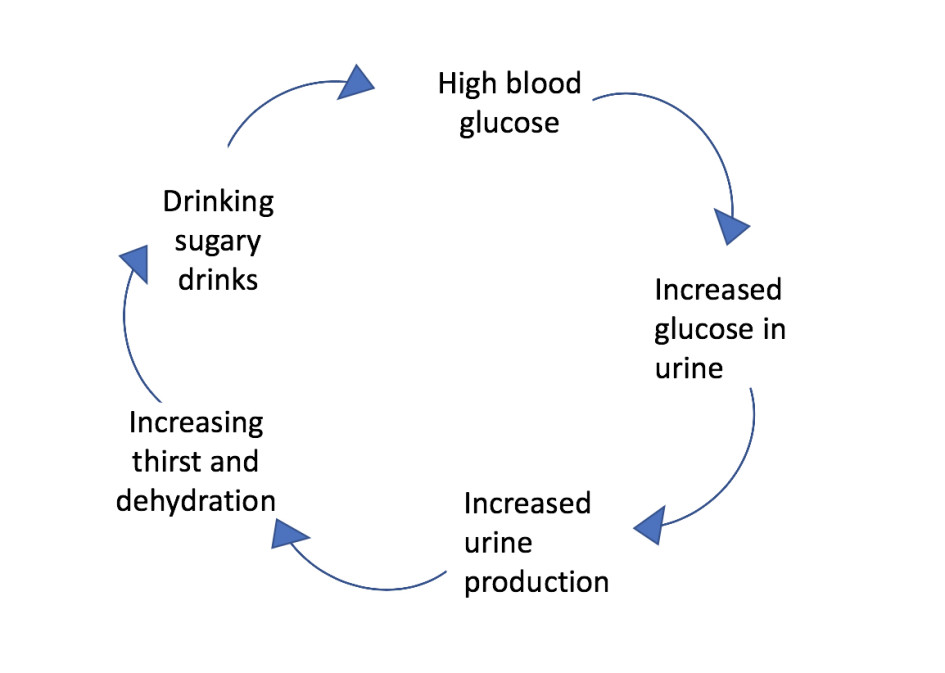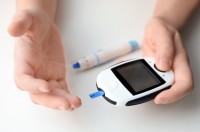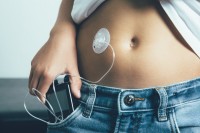- Home
- Dr Sultan Linjawi
Type 1 Diabetes
Type 2 Diabetes
Prediabetes
Gestational Diabetes
- Diabetes Information
- Testimonials
What are the symptoms of type 1 diabetes?

In diabetes mellitus, symptoms that you experience are related to:
a) the severity of diabetes, i.e. how high your blood glucose levels are,
and
b) how long you have had the condition, i.e. how long you have had high blood glucose levels for.
When a person initially develops type 1 diabetes, the beta cells of the pancreas rapidly fail to produce adequate amounts of insulin. Since there is little insulin, blood glucose levels rise very quickly. The symptoms of diabetes happen rapidly, are severe, and people notice that they are unwell quite quickly. If a person develops type 1 diabetes slowly, then these symptoms may take months to develop but often it is weeks.
Type 1 diabetes and diabetic ketoacidosis
Diabetic ketoacidosis (DKA) is a condition that occurs due to a build-up of poisonous chemicals, called ketones, in the bloodstream. DKA occurs in approximately 30% of children who present with type 1 diabetes (Diabetic Ketoacidosis in Infants, Children, and Adolescents). This causes the blood to become acidic, and the combination of acids and dehydration can lead to comas and potentially death.
DKA is a medical emergency and requires immediate medical treatment. Ketones can often be smelt on the breath and has a distinctive ‘nail polish’ smell. Low levels ketones are often normally present in prolonged starvation with or without diabetes.
Type 1 Diabetes Content |
|---|
| Type 1 Program |
| Overview |
| Risk Factors |
| Symptoms |
| Diagnosis |
| Complications |
| Treatment |
| Diet |
| Monitoring |
| Tools |
| Mental Health |
| Prevention |
In a person who has type 1 diabetes, the body isn’t able to use glucose for energy. Instead, stored fat in the body is used as a source of energy. It’s the breakdown of these fatty acids that results in the build-up of ketones, which can also appear in your urine.
Some symptoms of DKA include:
- Moderate to heavy ketones in the urine
- Rapid breathing
- Flushed cheeks
- Abdominal pain
- Sweet acetone (like nail polish remover) smell on the breath
- Vomiting
- Dehydration
What are the symptoms of type 1 diabetes?
The most common symptoms are thirst and excessive trips to the toilet to pass urine. This occurs as high blood glucose passes into the urine and with the glucose, goes water. If the blood glucose levels are very elevated, then only a small amount is able to get into the muscle and fat cells. This leads to profound weight loss and a rapid decline in muscle mass. In the early part of the illness, these symptoms can be mild and difficult to detect.
Most people with type 1 diabetes have symptoms of high blood glucose levels (hyperglycaemia). These symptoms can include:
- excessive thirst
- frequent urination
- feeling tired
- increased hunger
- unintentional weight loss
- blurred vision
- frequent yeast infections or urinary tract infections
- slow healing wounds
Excessive thirst, frequent urination, and dehydration
When your blood glucose levels are high, a lot of the glucose passes into the urine. Because you lose so much glucose in your urine, it also attracts water, meaning that you are making a lot of urine, causing you to need to pee a lot! If you are going to the toilet a lot and losing a lot of urine, then you are quickly becoming dehydrated. If you are dehydrated, you become thirsty. People who feel they need to constantly drink lots of water may have diabetes and it needs to be tested for.
If a person with high sugar tries to deal with their thirst by drinking sugar containing fruit juice or soft drinks, then the blood sugar can become even higher, resulting in even more sugar in the urine, even more urine production, and worsening dehydration. It’s a vicious cycle.

Fatigue and irritability
Fatigue is another common symptom of type 1 diabetes. You may often feel tired, regardless of how much you have eaten, because your cells are not able to use the glucose that is broken down from the food.
If you’re needing to make a lot of trips to the bathroom at night, this can also disrupt your sleep. Waking up multiple times throughout the night could mean you aren’t able to get a restful sleep, leaving you to feel tired throughout the day. This ongoing fatigue can make you easily irritable. It’s no wonder why you may be feeling more grumpy than usual!
Ongoing hunger
We get energy, like glucose, from the foods that we eat. People with diabetes, have little glucose entering the muscle cells, so the body will signal that it needs more food even though there is plenty in the blood. You may have ongoing hunger, regardless of how much you have already eaten, because the body is craving more energy.
Weight loss
If you have type 2 diabetes, there may come a time where you experience weight loss despite eating normally. This occurs when the glucose levels are very high and the pancreas is failing. This is a sign of severe diabetes. This results in not enough glucose being absorbed in the cells to be used for energy, so your body starts to breakdown fat and muscle instead, leading to the weight loss.
Blurred vision
This is a common complaint. Blurred vision occurs when glucose enters the lens in the eye ball. This causes it to swell, changing its shape and changing the refraction. This leads to a change in your eyesight. Some people will develop blurred and others might even notice an improvement in the eye sight! When the glucose levels fall back to more normal levels the lens changes shape again leading to a change in the visual acuity and a person’s eyesight. Many people are picked up as having diabetes by the opticians when they go for an eye check but is important to not get new glasses until the glucose levels are stable.
Yeast and bacterial infections
Yeast and other fungi use glucose for energy and thrive in an environment that is high in sugar. Yeast infections can occur in both men and women. Infections can grow in any place on the body that is a warm, moist fold of the skin, including:
- Between fingers and toes
- Under breasts
- In or around sex organs
People with high blood sugars also have a high risk of developing bacterial infections like urinary infections, chest infections, and skin infections and boils. The cells that fight infections are called neutrophils and their function is impaired if the glucose level is above 11mmol/l (or 200mg/dl).
Cuts and wounds that don’t heal quickly
Neutrophils, white blood cells that fight any infection in our body, are sensitive to high blood glucose levels. These are a very important part of the immune system and are at the front line of a person's defences, keeping bacterial infections at bay. In a person with diabetes, the ability of neutrophils to fight infections decreases, causing you to be less likely to able to fight infections, like a cut or a wound found on your foot.
Dry and itchy skin
When the body is dehydrated, our skin can become dry and feel itchy. Dry and itchy skin is more easily able to break, causing a cut or wound.
What to do if you think you might have type 1 diabetes?
The first thing if you suspect you may have diabetes is to visit your doctor and request a blood test. Your doctor may perform a finger prick test or a more accurate laboratory blood test. There are a number of ways to diagnose diabetes. Once diagnosed it is very important to get educated!! Once you know what is happening and what to do, you can get back to feeling good again.
What should I do next?
If you experience any symptoms of type 1 diabetes or you have risk factors for developing type 1 diabetes, it is important to get tested for as soon as possible. Some people are at higher risk and need regular testing.
By diagnosing and treating the type 1 diabetes early, it means you can decrease the risk of developing or delay any further health complications of type 1 diabetes, for example nerve damage, blindness, and heart disease. It is important to know that diagnosing type 1 diabetes should not rely solely on using a Hb A1c test.
Once you learn what your type 1 diagnosis is, or if you already have type 1 diabetes, the next most important step is to become educated. You can join the 12-week Type 1 Diabetes Program to help you learn how best to manage the condition. For example, you can learn how best to monitor blood glucose levels in type 1 diabetes. The program is personalised and tailored, giving you more of the content that you want. The program also helps you to stay motivated and teaches you what changes you need to make. The first week is free and full of helpful and crucial information.
Interested in more information on type 1 diabetes?
Follow the links below to learn more about type 1 diabetes.





